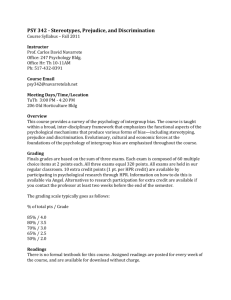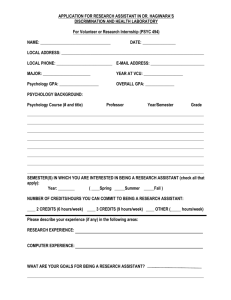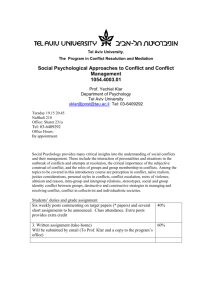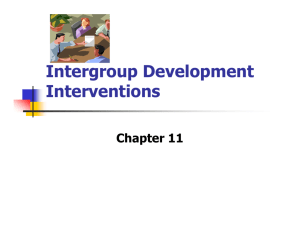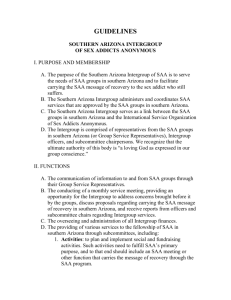אוניברסיטת תל אביב
advertisement
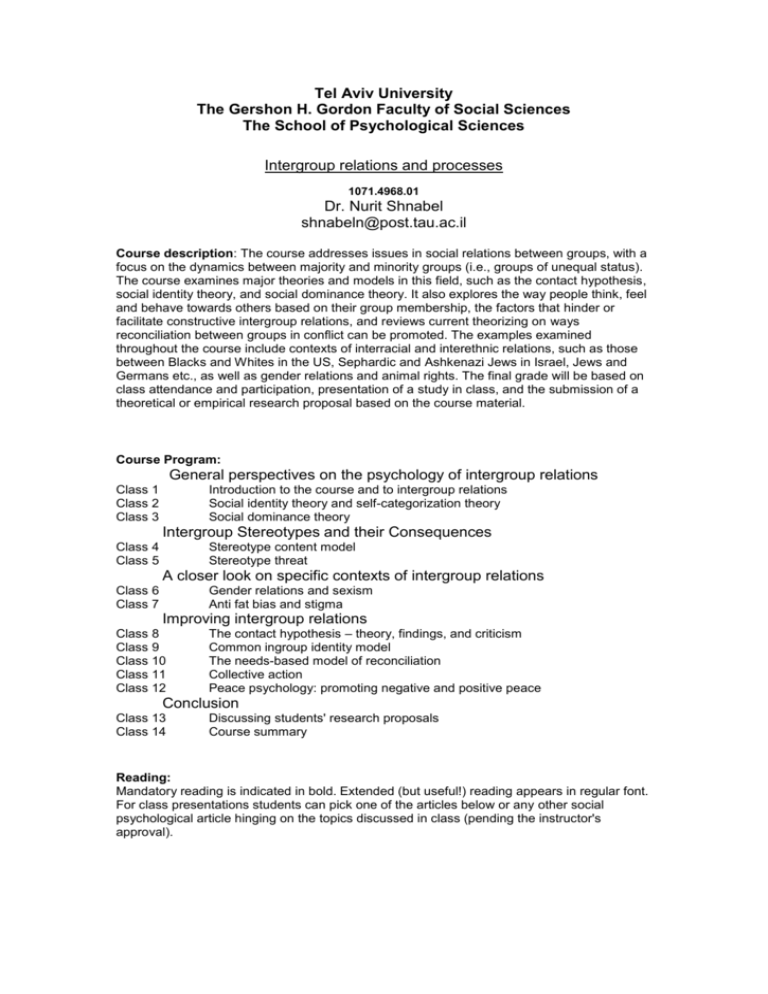
Tel Aviv University The Gershon H. Gordon Faculty of Social Sciences The School of Psychological Sciences Intergroup relations and processes 1071.4968.01 Dr. Nurit Shnabel shnabeln@post.tau.ac.il Course description: The course addresses issues in social relations between groups, with a focus on the dynamics between majority and minority groups (i.e., groups of unequal status). The course examines major theories and models in this field, such as the contact hypothesis, social identity theory, and social dominance theory. It also explores the way people think, feel and behave towards others based on their group membership, the factors that hinder or facilitate constructive intergroup relations, and reviews current theorizing on ways reconciliation between groups in conflict can be promoted. The examples examined throughout the course include contexts of interracial and interethnic relations, such as those between Blacks and Whites in the US, Sephardic and Ashkenazi Jews in Israel, Jews and Germans etc., as well as gender relations and animal rights. The final grade will be based on class attendance and participation, presentation of a study in class, and the submission of a theoretical or empirical research proposal based on the course material. Course Program: General perspectives on the psychology of intergroup relations Class 1 Class 2 Class 3 Introduction to the course and to intergroup relations Social identity theory and self-categorization theory Social dominance theory Intergroup Stereotypes and their Consequences Class 4 Class 5 Stereotype content model Stereotype threat A closer look on specific contexts of intergroup relations Class 6 Class 7 Gender relations and sexism Anti fat bias and stigma Improving intergroup relations Class 8 Class 9 Class 10 Class 11 Class 12 The contact hypothesis – theory, findings, and criticism Common ingroup identity model The needs-based model of reconciliation Collective action Peace psychology: promoting negative and positive peace Conclusion Class 13 Class 14 Discussing students' research proposals Course summary Reading: Mandatory reading is indicated in bold. Extended (but useful!) reading appears in regular font. For class presentations students can pick one of the articles below or any other social psychological article hinging on the topics discussed in class (pending the instructor's approval). Class number: 1 Jones, J.M., Zimbardo, P.G., Goldberg, L., Kaufman, B., & King, I. (1996). Psychological mechanisms of prejudice - Intergroup Relations I: Theory and Research. In: Prejudice and racism (pp. 203-235). NY: McGraw-Hill Higher Education. 2 Jones, J.M., Zimbardo, P.G., Goldberg, L., Kaufman, B., & King, I. (1996). The prejudiced personality: Are some people more likely to feel prejudice? In: Prejudice and racism (pp. 85-106). NY: McGraw-Hill Higher Education. 3 Jost ,J. T., & Hunyady, O. (2005). Antecedents and consequences of systemjustifying ideologies. Current Directions in Psychological Science, 14, 260-265. 4 Fiske, S. T., Cuddy, A. J. C, Glick, P., & Xu, J. (2002) A model of (often mixed) stereotype content: Competence and warmth respectively follow from perceived status and competition. Journal of Personality and Social Psychology, 82, 878-902 Leach, C.W., Ellemers, N. & Barreto, M. (2007). Group virtue: The importance of morality (vs. competence and sociability) in the positive evaluation of in-groups. Journal of Personality and Social Psychology, 93, 234-249. 5 Steele, C. M., Spencer, S., & Aronson, J. (2002). Contending with group image: The psychology of stereotype and social identity threat. In M. Zanna (Ed.), Advances in Experimental Social Psychology Vol. 37. Academic Press. Cohen, G.L., Garcia, J., Apfel, N. & Master, A. (2006). Reducing the racial achievement gap: A social-psychological intervention. Science, 313, 13071310. 6 Glick, P., & Fiske, S. T. (2001). An ambivalent alliance: Hostile and benevolent sexism as complementary justifications for gender inequality. American Psychologist, 56, 109–118. Glick, P., & Fiske, S. T. (1996). The Ambivalent Sexism Inventory: Differentiating hostile and benevolent sexism. Journal of Personality and Social Psychology, 70, 491–512. Glick, P., Lameiras, M., Fiske, S..T., Eckes, T., Masser, B., Vopato, C., et al. (2004). Bad but bold: Ambivalent attitudes toward men predict gender inequality in 16 nations. Journal of Personality and Social Psychology, 86, 713-728. 7 Puhl, R.M., & Heuer, C.A. (2009). The stigma of obesity: A review and update. Obesity, 1-23. Crandall, C. S. (1994). Prejudice against fat people: Ideology and self-interest. Journal of Personality and Social Psychology, 66 882-894. 8 Dixon, J.A., Durrheim, K. & Tredoux, C. (2005). Beyond the optimal strategy: A “reality check” for the contact hypothesis. American Psychologist, 60, 697711. Pettigrew T.F., & Tropp, L.R. (2006). A meta-analytic test of intergroup contact theory. Journal of Personality and Social Psychology, 90, 751-783. 9 Dovidio, J. F., Gaertner, S. L, & Saguy, T. (2007). Another view of “we”: Majority and minority group perspectives on a common ingroup identity. European Review of Social Psychology, 18, 296-330. Gaertner, S.L., Dovidio, J.F., Banker, B.S., Houlette, M., Johnson, K.M., McGlynn, E.A. (2000). Reducing intergroup conflict: From superordinate goals to decategorization, recategorization, and mutual differentiation. Group Dynamics: Theory, Research, and Practice, 4, 98-114. 11 Shnabel, N., Nadler, A., Canetti-Nisim, D., & Ullrich, J. (2008). The role of acceptance and empowerment from the perspective of the Needs-Based Model. Social Issues and Policy Review, 2, 159-186. Shnabel, N., Nadler, A., Dovidio, J.F. & Ullrich, J. (working paper). The effects of receiving messages of empowerment and acceptance on the intergroup orientations of members of high and low status groups. 11 Leach, C. W., Snider, N., & Iyer, A. (2002). "Poisoning the consciences of the fortunate": The experience of relative advantage and support for social equality. In I. Walker & H.J. Smith (Eds.), Relative deprivation: Specification, development, and integration (pp. 136-163). New York, NY: Cambridge University Press; US. Iyer, A. & Leach, C. W. (in press). Helping disadvantaged out-groups challenge unjust inequality: The role of group-based emotions. In S. Stürmer and M. Snyder (Eds.), The Psychology of Prosocial Behavior: Group Processes, Intergroup Relations, and Helping. Wiley-Blackwell. Christie, D.J., Tint, B.S., Wagner, R.V., & Winter, D.D. (2008). Peace 12 psychology for a peaceful world. American Psychologist, 63, 540-552. 13 Additional reading (will not be discussed in class): intergroup relations in organizations. Brickson, S. L., & Brewer, M. B. (2001). Identity orientation and intergroup relations in organizations. In M.A. Hogg and D.J. Terry (Eds.), Social identity processes in organizational contexts: Psychology Press, Philadelphia, (pp. 49-66). Haslam, A. S. (2001). Psychology in organizations - The social identity Approach. London: Sage.


